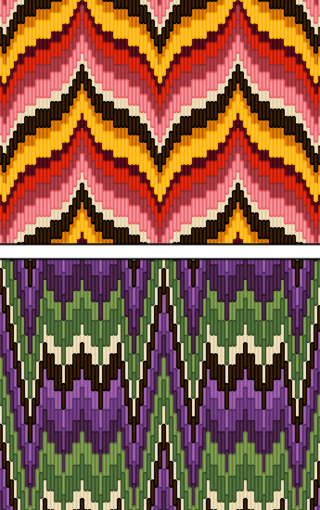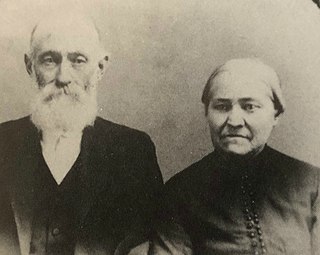
Quilting is the process of joining a minimum of three layers of fabric together either through stitching manually using a needle and thread, or mechanically with a sewing machine or specialised longarm quilting system. An array of stitches is passed through all layers of the fabric to create a three-dimensional padded surface. The three layers are typically referred to as the top fabric or quilt top, batting or insulating material, and the backing.

Patchwork or "pieced work" is a form of needlework that involves sewing together pieces of fabric into a larger design. The larger design is usually based on repeating patterns built up with different fabric shapes. These shapes are carefully measured and cut, basic geometric shapes making them easy to piece together.

A quilt is a multi-layered textile, traditionally composed of two or more layers of fabric or fiber. Commonly three layers are used with a filler material. These layers traditionally include a woven cloth top, a layer of batting or wadding, and a woven back combined using the techniques of quilting. This is the process of sewing on the face of the fabric, and not just the edges, to combine the three layers together to reinforce the material. Stitching patterns can be a decorative element. A single piece of fabric can be used for the top of a quilt, but in many cases the top is created from smaller fabric pieces joined, or patchwork. The pattern and color of these pieces creates the design. Quilts may contain valuable historical information about their creators, "visualizing particular segments of history in tangible, textured ways".

A patchwork quilt is a quilt in which the top layer may consist of pieces of fabric sewn together to form a design. Originally, this was to make full use of leftover scraps of fabric, but now fabric is often bought specially for a specific design. Fabrics are now often sold in quarter meters. A "fat quarter" is one square meter folded into four and cut along the folds, thus giving a relatively square piece of fabric 50 cm on a side, as opposed to buying a quarter of a meter off the roll, resulting in a long thin piece that is only 25 cm wide.

Bargello is a type of needlepoint embroidery consisting of upright flat stitches laid in a mathematical pattern to create motifs. The name originates from a series of chairs found in the Bargello palace in Florence, which have a "flame stitch" pattern.

In geometry, the rhombille tiling, also known as tumbling blocks, reversible cubes, or the dice lattice, is a tessellation of identical 60° rhombi on the Euclidean plane. Each rhombus has two 60° and two 120° angles; rhombi with this shape are sometimes also called diamonds. Sets of three rhombi meet at their 120° angles, and sets of six rhombi meet at their 60° angles.

The history of quilting, the stitching together of layers of padding and fabric, may date back as far as 3400 BCE. For much of its history, quilting was primarily a practical technique to provide physical protection and insulation. However, decorative elements were often also present, and many quilts are now primarily art pieces.
Quilts of the Underground Railroad describes a controversial belief that quilts were used to communicate information to African slaves about how to escape to freedom via the Underground Railroad. It has been disputed by a number of historians.
Eleanor Burns is a master quilter and former TV series host of Quilt in a Day, which aired in 1994 on PBS for six seasons.
Barbara Brackman is a quilter, quilt historian and author.
The Hat and Fragrance Textile Gallery is an exhibit space at Shelburne Museum in Shelburne, Vermont which houses quilts, hatboxes, and various other textiles. The name "Hat and Fragrance" refers both to Electra Havemeyer Webb's collection of hatboxes and to the fragrant, herbal sachets used to preserve textiles. In 1954, Shelburne Museum was the first museum to exhibit quilts as works of art; prior to this exhibition quilts were only shown as accessories in historic houses.

John Lefelhocz is an American conceptual artist primarily known for his works in the textile arts, specifically art quilts. He attended Ohio University. Since college, he has owned and operated Cycle Path Bicycle Shop in Athens, at the same time establishing himself as an artist. His art gained higher recognition in the late 1990s. This can be attributed to inclusion in several Quilt Nationals. He has subsequently shown his works throughout the US and abroad.
Michael Francis James is an American artist, educator, author, and lecturer. He is best known as a leader of the art quilt movement that began in the 1970s. He currently lives and maintains a studio in Lincoln, Nebraska.

Chinese patchwork is a traditional form of Chinese needlework which has been widely circulated in Chinese folk arts. In China, patchwork has been used for millennia.

The conservation and restoration of quilts refers to the processes involved in maintaining the integrity of quilts and/or restoring them to an acceptable standard so that they may be preserved for future generations. Quilts have been produced for centuries, as utilitarian blankets, decorations, family heirlooms, and now treasured museum collections objects. Quilts are three-layered textile pieces with a decorated top, a back, and a filler in the middle. The composite nature of these objects creates an interesting challenge for their conservation, as the separate layers can be made of different textile materials, multiple colors, and therefore, varying degrees of wear, tear, and damage.

Susan McCord was an American quilter. She is best known for her innovative designs and exquisite craftsmanship. Thirteen of McCord's quilts are included in the permanent collection of the Henry Ford Museum in Dearborn, Michigan.
Geraldine Elizabeth Kahle Beyer is an American quilt designer, quilter, author, teacher and lecturer. Considered by the quilting industry and the publishing media to be of the first designers to form a fabric collection suited to the needs of quilters, she began her career in India after she had run out of yarn. Beyer's works have won awards in the print media, and she has written about the history of quilting and her techniques. She has designed collections for fabric companies, and has taught and lectured on the subject domestically and internationally. Beyer was inducted into the Quilters Hall of Fame in 1984.
Lucinda Toomer was an American artist who worked in the African-American tradition of quiltmaking. Her quilts are known for their bold compositions, visual rhythm, and improvisational style. They were at the forefront of a surge of national recognition for the art form during the 1990s.

Pineapple mania, also known as pineapple fever, was a period of intense fascination with pineapples in Europe that spanned approximately 150 years, from the early 18th century to the mid-to-late-19th century. The craze was ignited by the introduction of pineapples from the New World, captivating European royals and horticulturalists who sought to cultivate the exotic fruit. The difficulty of growing pineapples in colder climates contributed to their scarcity and exorbitant cost, establishing them as symbols of great wealth, power, and status. Unlike most fruits known at the time, which had representation in extensive bodies of knowledge and literature dating back to antiquity, the pineapple was entirely novel, inspiring imaginative and fantastical representations in popular culture. This perception influenced cuisine, decorative arts, architecture, philosophy, and technology in Europe and the newly formed United States.




















